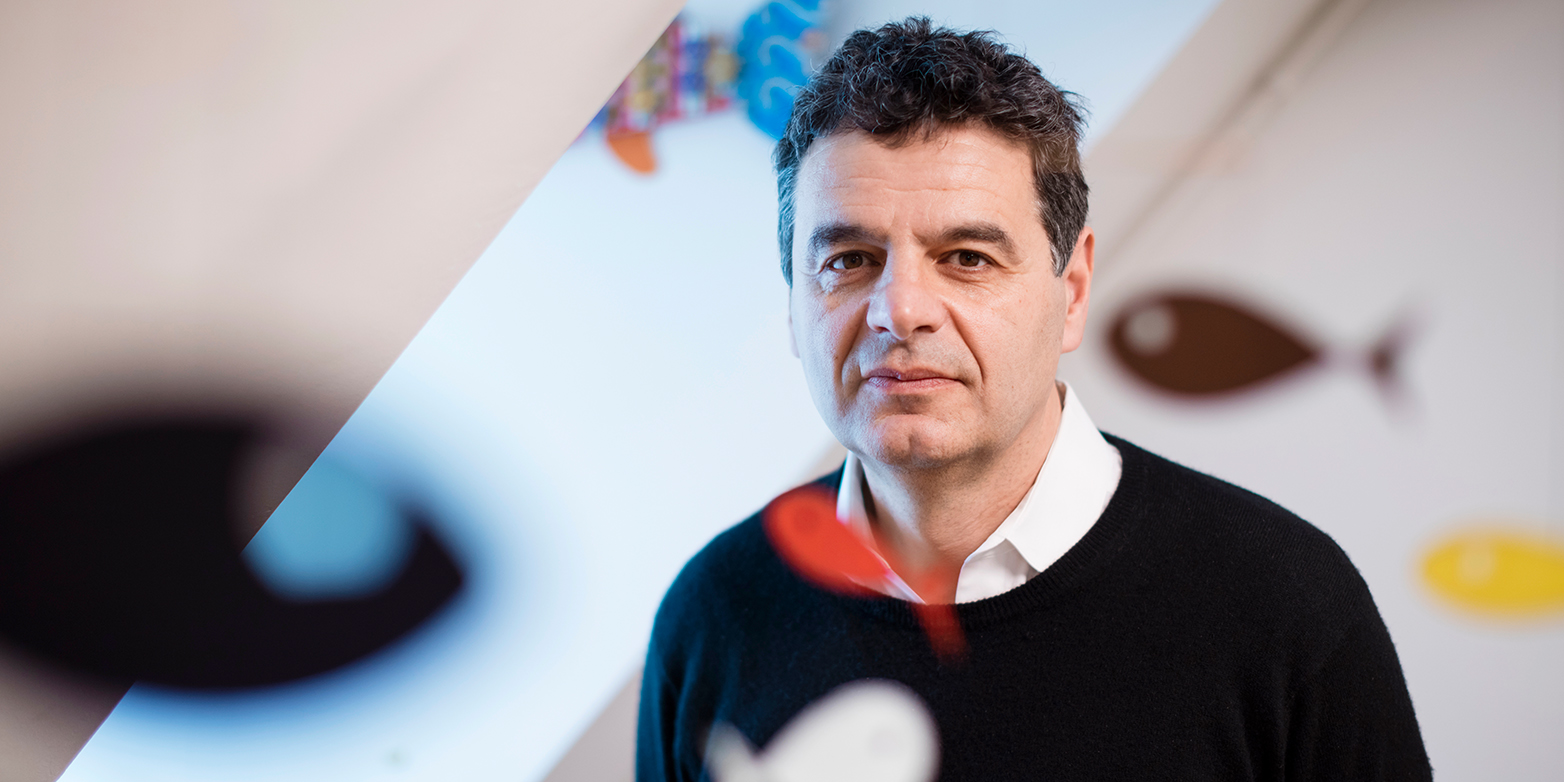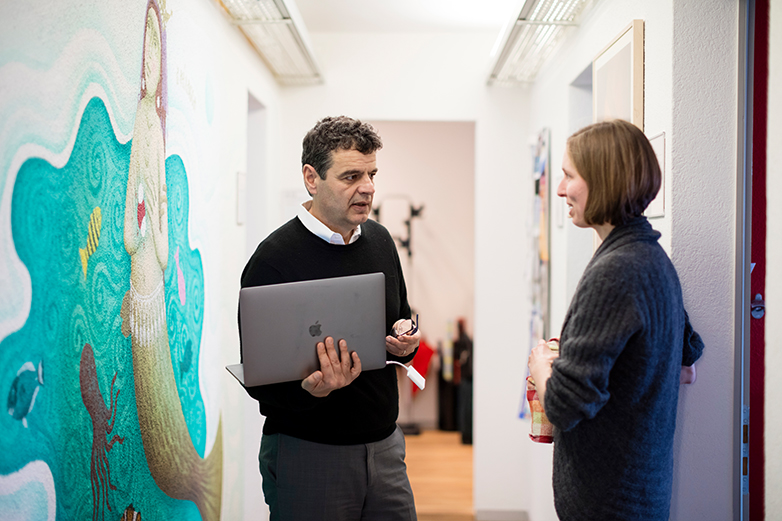A research career shaped by supercomputing
ETH Professor Petros Koumoutsakos wanted to embark on a career at the United Nations. Today, he is one of the world’s leading researchers in the simulation of fluid dynamics using supercomputers.

On the way to Petros Koumoutsakos’ office, the stairwell and corridors are adorned with elaborate graffiti, and his office is decorated with mobiles. The scenes include shoals of blue fish, a mermaid and a sailing boat; there is an overarching theme about the dynamics of wind and water. Fluid dynamics are, after all, the focus of his research. As Professor of Computational Sciences at ETH Zurich, Koumoutsakos performs simulations on supercomputers to research the swimming behaviour of fish, the growth of tumours and blood vessels, multiscale processes in biological cells or the interactions of water with nanoparticles and carbon nanotubes.
The dynamics of wind and water seem to be in his blood, so to speak: now in his mid-50s, Koumoutsakos grew up in Gytheio, a small fishing village south of Sparta in the Peloponnese. Water was part of everyday life for the young Greek. His father had a fishing boat, in which the family used to head out to sea in their spare time. “We didn’t have a TV, and as children we spent a lot of time daydreaming. On Sundays, we went to the cinema after church. Imagine something along the lines of the film ‘Cinema Paradiso,’” he says.
Doing more good
Koumoutsakos left these idyllic-sounding circumstances as a young man to study Naval Architecture in Athens. Although he had wanted to be a physicist since the age of 12, he ultimately decided against it. He was worried that he would not make the cut for a PhD and would therefore have to spend the rest of his life teaching. Instead, he chose to work on things independently and do more with his life.
After earning his degree and then two Master’s in the USA, he stayed there to pursue a doctorate in Aeronautics. He then sought to follow his dream of working for the United Nations (UN). Even today, he advises his students not to set their sights solely on publications, citations and money, but to do something that benefits both science and the people of this world.
Failure as a driving force
Despite his ambition, all his applications to the UN’s development programme were unsuccessful. Koumoutsakos openly admits that failures are hard for him, but that they are also a continual source of renewed motivation. He recalls his earliest memory of this in school: at the age of ten, he failed to achieve the maximum 10 points in an exam for the first time, scoring just 8 instead. His parents tried to convince him that, just once, his performance in an exam might be worse than he was actually capable of. He was deeply shaken by this at the time.

After the UN’s rejection, Koumoutsakos remained in the USA for two postdoc positions: he carried out research in the field of supercomputing at the California Institute of Technology and in the control of turbulent flows at Stanford University. In parallel to this, he attended courses in neuroscience and psychology, as he actually wanted to switch his career to neuroscience afterwards. Though that switch would not come to pass either, the detour would play a role later in his career. Twenty-one years ago, he took up the position of Assistant Professor in Computational Fluid Dynamics at ETH Zurich. When he became Professor in Computer Science 3 years later, he was the first to teach machine learning at ETH Zurich after having been inspired by his foray into neuroscience research.
The common denominator
Koumoutsakos has ultimately witnessed the development of (super)computing from close quarters. He was already working with computers during his diploma thesis in Athens – which still used punch cards at the time. He has never managed to get away from computing since. “From my first day at ETH, the supercomputers at the Swiss National Supercomputing Centre (CSCS) have been the most important tool in my work,” he says.
At the same time, Koumoutsakos always seeks an interdisciplinary exchange of ideas with his colleagues in order to gain an insight into the subject area in question. To this end, he once worked in the laboratory of ETH Professor of Biochemistry Ari Helenius (now emeritus) for a few months, and elsewhere he dissected mice suffering from cancer for his research on tumour growth. However, no matter how varied Koumoutsakos’ interdisciplinary research projects may sound, they have one common denominator: studying fluid mechanics at all scales with models, algorithms, data and of course computers.
Uses supercomputers efficiently
The ETH Professor is passionate about science and has made a name for himself in his field. This is clear from his numerous awards, such as the prestigious Gordon Bell Prize that he received in 2013 and was nominated for again in 2015, as well as his recent election to the American National Academy of Engineering (see box). Part of the reason for his success is that when he uses cutting-edge supercomputers, he tries to ensure that he does so efficiently.
"My students didn’t want to give up – and so we won the Gordon Bell Prize."Petros Koumoutsakos
“Computing is essential for the progress of humankind,” it says on Koumoutsakos’ website. He explains that supercomputing has helped us to achieve breakthroughs in many areas of research, such as climate modelling or genome sequencing. “All modern cars, ships and planes have been developed on a computer.” In order to solve truly complex problems, the scientist sees no other approach than involving computing.
Not giving up even when all seemed lost
In addition to utilizing the computers, he views his endeavours as a process of working with his group as a team. “I have been blessed with extraordinary students,” he says, adding that he is a strict mentor and expects his students to be genuinely interested in – and passionate about – what they do. It is also important to him that his students are not afraid of anything, because, as he says, nothing is unsolvable – even though he also has doubts at times. If anything, life has taught Koumoutsakos that there is almost always a way out, as the example of the Gordon Bell Prize in 2013 shows.
Shortly before the submission deadline, Koumoutsakos and his team were unable to test the software of their competition entry, as they had not obtained any computing time on one of the most powerful supercomputers available. It was only thanks to a lucky coincidence that they obtained five hours of computing time at short notice. Unfortunately, the first attempt failed. It seemed as if all was lost. “But my students didn’t want to give up. The code stopped due to a bug that was discovered at the last minute – and so we won the Gordon Bell Prize,” Koumoutsakos says. He will remember that moment, of his students not giving up even when all seemed lost, for the rest of his life.
Admitted to the National Academy
A few weeks ago, Petros Koumoutsakos was elected as a foreign member of the National Academy of Engineering. Founded in 1964, the American academy has over 2,000 members, 262 of whom are from foreign institutions – including ten members from Switzerland. Other members from ETH Zurich include Martin Fussenegger, Professor at the Department of Biosystems Science and Engineering (D-BSSE); and Professors Emeritus Göran Andersson, Manfred Morari and Niklaus Wirth.
This article was first published on the external page CSCS website.
Comments
No comments yet